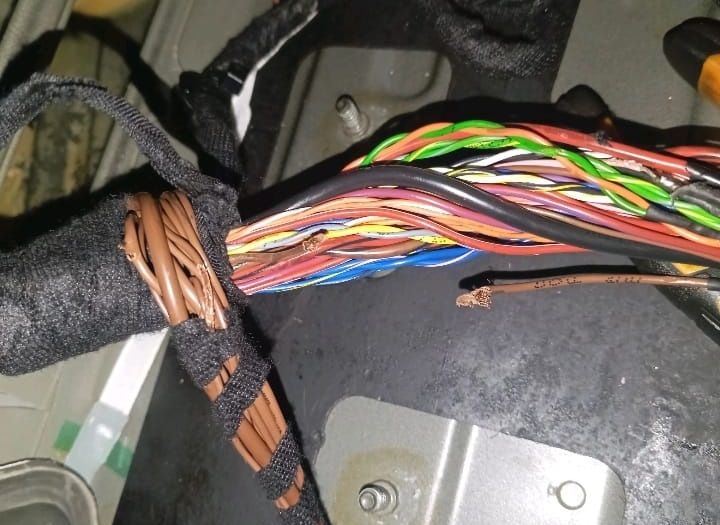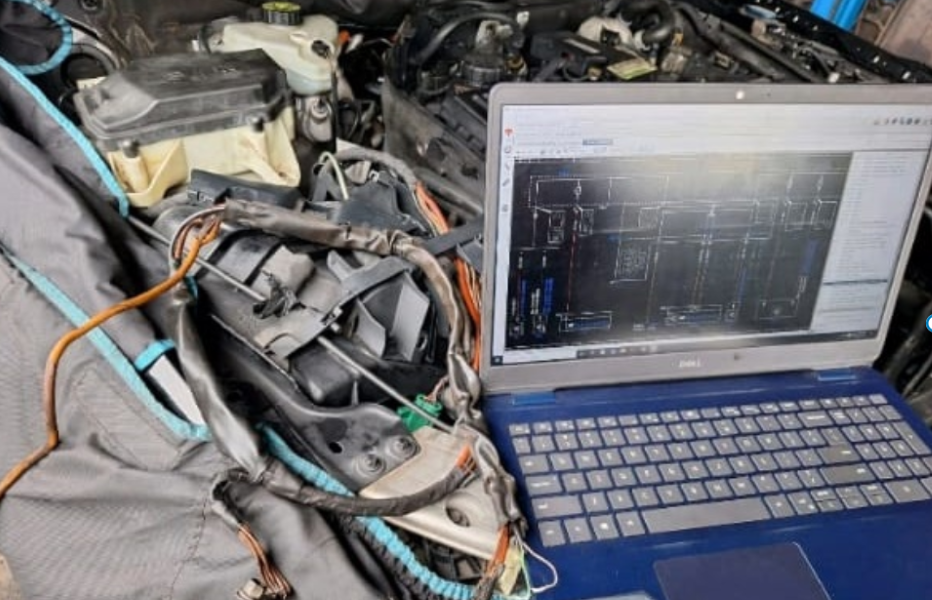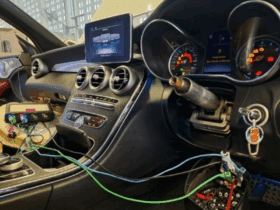Table of Contents
Mercedes Electrical Problems guide
Electrical problems in modern Mercedes-Benz vehicles can feel like chasing invisible wires one warning light today, a non-starting engine tomorrow. Under the surface, your car is powered by dozens of control modules communicating over a high-speed CAN bus network and smaller LIN sub-buses.
When a fault occurs in the SAM (Signal Acquisition Module), ECU (Engine Control Unit), or wiring harness, it can cripple several systems at once.
This guide explains how to diagnose and fix Mercedes electrical problems step by step, using real workshop experience and OEM-level diagnostic logic. Whether you’re facing a random warning light, a no-communication fault, or a dead dashboard, this hub will help you find and fix the real cause.
Common Mercedes Electrical Problems
Electrical faults can manifest in many forms, from subtle flickering lights to complete system failure. Here are the most frequent culprits:
- – SAM Module Failure: Often due to water ingress or internal corrosion, leading to lighting, locking, and communication issues.
- – ECU Power Loss: A faulty relay or fuse may cut voltage supply to the engine or transmission control units.
- – CAN Bus Interference: Short circuits or open lines disrupt data communication between modules.
- – Poor Ground Connection: Corroded or loose ground points cause voltage drops and unpredictable warnings.
- – BMS (Battery Management System) Faults: In 48-V or hybrid models, a weak auxiliary battery can interrupt power flow.
- – Wiring Harness Damage: Rodents, humidity, or previous repairs may cause hidden breaks or shorts.
Ignoring these symptoms can trigger limp mode, no-start conditions, or multiple cascading errors across the network.
Symptom, Cause, Fix Overview
| Symptom | Likely Cause | Fix |
|---|---|---|
| Engine won’t start | SAM or ECU not powered | Check fuses, relays, ground continuity |
| Random warning lights | CAN network interference | Inspect harness, verify termination resistance |
| Headlights or wipers inoperative | SAM internal failure | Replace and code new SAM unit |
| Transmission or ESP errors | LIN sub-bus failure | Check connectors and continuity |
| Battery drain overnight | Shorted control module | Measure parasitic draw and isolate fault |
| Water under carpets | Wiring harness corrosion | Repair harness and reseal floor drains |
Professional Diagnostic Approach
Electrical diagnosis on a Mercedes isn’t guesswork it’s a process.
Here’s the method followed in professional workshops:
- 1. Perform a Full System Scan
Use Mercedes XENTRY Diagnosis or an equivalent OEM tool to identify which control units fail to communicate. - 2. Check Power & Grounds
Confirm voltage at ECU pins and SAM connectors using a multimeter. A missing 12 V or poor ground is often the silent culprit. - 3. Inspect CAN & LIN Signals
With an oscilloscope or PiCAN3 sniffer, examine waveform symmetry and bus activity. A healthy CAN line alternates around 2.5 V; distorted signals indicate interference. - 4. Search for Water Damage or Shorts
Lift carpets, remove seat trims, and inspect fuse boxes. Water under the center console is a common reason for SAM and BMS failures. - 5. Replace or Reprogram the Faulty Module
If a control unit is defective, install a genuine part and perform SCN coding or variant coding using DTS Monaco or Vediamo. - 6. Clear Fault Codes & Verify Communication
Re-run the full diagnostic scan to confirm every module responds and that no new faults appear.
Grouped Case Studies by Subtopic
ECU & Communication Faults
– Mercedes Benz Not Starting – Body Control Module (SAM) Fault
Water intrusion under the center console caused SAM failure and communication loss; issue resolved after module replacement and coding.
– Car Turns Over But Won’t Start – Fuel Pump Control Unit Fault (W213)
No fuel delivery traced to defective fuel pump ECU; replaced and reprogrammed successfully.
– Problem Starting Car – CLA 45 (W118) ME Control Unit Fault
Faulty ME ECU voltage line identified via continuity test; replacement restored normal start sequence.
– AdBlue Reset Mercedes: Causes & Reset Procedure
AdBlue system required ECU and SCR module reset after injector repair; showcases proper diagnostic flow.
– Mercedes W206 Problems – High Voltage Battery BMS Fault
Isolation resistance fault in BMS control unit; corrected after HV battery replacement.

Power Supply & Short Circuit Issues
– Problem with Power Steering – Short Circuit in Steering Rack (C350e)
Oil leak caused internal short in the steering rack’s control board, disrupting CAN signals.
– Auxiliary Battery Malfunction Mercedes
Low auxiliary voltage triggered repeated module resets; resolved by replacing the secondary battery.
– Car Will Turn But Not Start – Mercedes A-Class W177
Fuel control circuit lost power feed; fuse and wiring repair restored ECU operation.
– Transmission Shifting Problems – Mercedes E300 W212 (722.9)
TCU communication restored after correcting voltage drop on gearbox harness.
– Car Dies While Driving – Mercedes GLE W167 (OM654)
Intermittent power interruption traced to fuel rail pressure control wiring fault.

Water Damage & Wiring Harness Issues
– Mercedes Benz Not Starting – Water Under Center Console (W463)
Water damage on SAM connectors caused CAN corrosion; repaired harness and resealed cabin drains.
– Active Brake Assist Functions Limited – Diagnostic Case Study
Radar module lost communication with ESP via chassis CAN; wiring fault repaired.
– Mercedes EQB Issue – ADS Control Unit Wiring Damage
Rodent damage on ADS power supply harness fixed; control unit communication restored.
– Airmatic Mercedes Problem – GL 500 Suspension Drop
Valve block wiring fault on chassis CAN bus corrected after calibration.
– Cooling System Fault – Mercedes EQ Model
Stuck expansion valve (Y140/1) traced to LIN communication error; valve replaced and system rechecked.

Understanding the SAM, ECU & CAN Bus Relationship
- – SAM (Signal Acquisition Module): The gateway distributing power and communication to lighting, wipers, and comfort features. Think of it as the car’s smart fuse box.
- – ECU (Engine Control Unit): The brain controlling fuel injection, timing, and emissions. A voltage drop or ground fault here often triggers “Check Engine” or limp mode.
- – CAN Bus (Controller Area Network): The nervous system linking every module. A break in this network can make multiple systems appear faulty when only one line is open.
When troubleshooting, remember that a CAN fault in one area can silence unrelated modules always start by restoring network integrity before replacing parts.
Prevention & Maintenance Tips
- – Keep the cabin and trunk drain holes clean to avoid water intrusion.
- – Regularly inspect under-seat fuse boxes and connectors for corrosion.
- – Maintain battery health; a weak battery can disrupt communication networks.
- – Avoid jump-starting without surge protection.
- – After any module replacement, always perform SCN coding to synchronize configurations.
Related Troubleshooting Hubs
– Mercedes No Start Issues: Causes, Fixes & Case Studies
– Mercedes Check Engine Light: Complete Troubleshooting Hub
– Mercedes Cooling System Problems Guide: Troubleshooting
– Mercedes-Benz Suspension Issues : Symptoms, Causes & Fixes
– Mercedes AdBlue Problems: Causes, Fixes & Reset Guide
These interconnected hubs build a complete Mercedes diagnostic library designed for both technicians and advanced enthusiasts.
Author Bio
Mercedes Expert is an automotive technical trainer and Mercedes-Benz diagnostics expert with extensive hands-on experience in XENTRY, DTS Monaco, and advanced system troubleshooting. He specializes in transforming real workshop case studies into structured learning content to help technicians, car owners, and enthusiasts understand complex vehicle systems.
Follow more technical guides and training resources on Mercedes Assistance.






Leave a Reply